Asset Auditing during the Pandemic
Are you struggling to complete the asset audit in the covid period, worried about the audit compliance?

Pandemic has changed the working style of business, you no longer need a brick and mortar office or call employees to work. Employees are working from home effectively, only you need to provide them a laptop and other assets to do their job. The new style is effective and the need of the hour but at the same time auditing the assets physically becomes a pain. Asset audit in the covid period ? How auditors will verify the assets, how will they take care of compliance as compliance like Caro clause 4i has not changed.
Here are a few things you can do
Method 1: Manual Method
Asset audit in the covid period
You can prepare a list of all the assets with users using the mail and merge the function of the excel tool and then send it to all the users to revert with the confirmation of assets. You need to manually verify each mail and collate the data for the final report.
All mismatched data need to be updated in the finance record and the same mails can be stored for future reference.
Method 2:
Use ITM automation tool that has an inbuilt feature of automating the process of audit using three combinations. One by email verification and report generation. Second, using the ITM mobile app with an inbuilt GPS-based camera and date & time stamp on each photo.
This helps the companies to reduce the overall efforts required for audit and at the same time manage the compliance.
What KPMG says?
Asset audit in the covid period
Due to various restrictions imposed currently as part of measures to combat the COVID-19 outbreak, in certain
cases, it could be difficult for auditors to physically attend the inventory count organized by a company. In that case, management would need to demonstrate controls over inventory movements and an auditor should be able
to test and place reliance on them.
Auditors would need to perform alternative audit procedures to obtain audit evidence as to the existence and condition of inventory, for example, observing
a current physical inventory count and reconciling it to the opening inventory quantities or inspection of
documentation of the subsequent sale of specific inventory items acquired or purchased prior to the physical inventory counting.
If the challenges persist and auditors are not able
to obtain sufficient appropriate audit evidence by performing alternative procedures, then depending on the pervasiveness of the scope limitations, this may
result in a modification of opinion in an auditor’s report.
If auditors had attended the last inventory count, then management would need to provide information to help auditors perform roll forward procedures. Roll forward procedures for the intervening period may include, among others, the following:
- Vouching purchases of inventory during the intervening period to and from perpetual records
- Vouching sales of inventory during the intervening period to and from perpetual records
- Performing substantive analytical procedures to evaluate sales, gross margin percentages, inventory turnover, and/or days sales in inventory
- Testing inventory sales and purchases for proper cut-off at period end
- Testing the accuracy of the inventory reconciliation to the general ledger at period end, including tests of reconciling items.
An auditor would need to consider whether roll-forward procedures could provide sufficient appropriate audit
evidence. Generally, as the length of the roll-forward period increases, the persuasiveness of the audit evidence the previous inventory count combined with roll-forward procedures provides for the existence of physical inventory quantities at the reporting date
decreases. This is because an auditor can only sample transactions that were recorded during the roll-forward period, and there is a risk that inventory movements may not have been recorded. This risk increases as the roll-forward period get longer. In addition, roll-forward procedures do not provide evidence as to the condition of inventory at the reporting date.
Use of technology in inventory count
In certain situations where physical attendance by auditors is not possible, they may be able to observe the count remotely via video call with the help of technology. An auditor would need to ensure the security of these applications. The auditors would need to understand the technological and practical constraints to observing an inventory count remotely. If auditors are observing a count remotely, they would need to perform the same procedures as if attending in person. Asset audit in the covid period


